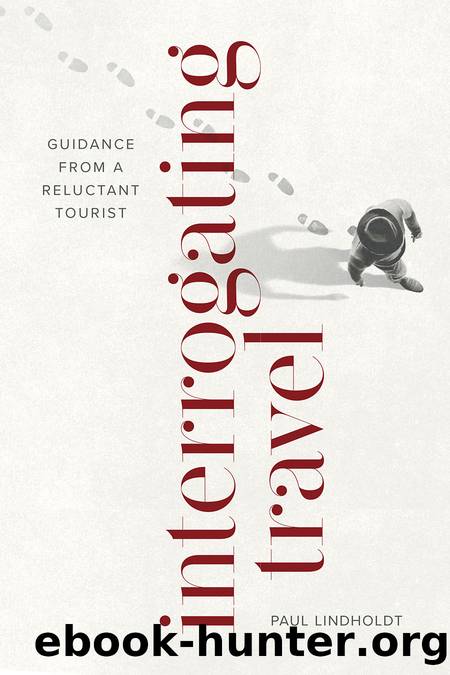Interrogating Travel by Paul Lindholdt

Author:Paul Lindholdt
Language: eng
Format: epub
Publisher: LSU Press
Published: 2023-05-07T00:00:00+00:00
among
the indigenous
13
Tracking Captain Cook
At Kahaluu Beach Park on the Kona coast, we navigated the parking lot, discovered a spot, and unhinged our limbs from the rented car. Young women in bikinis and families from middle America vied for bits of rock and sand. From those bits they entered the sea. We entered right beside themâsnorkels, masks, and fins in handsâto take the lay of the land and water.
Rising near shore amid vigorous waves, the mounded shell of a large green turtle swayed. People crowded in to inspect the reptile. Its feet braced. Its beaked head tore live algae from ancient coral that had perished long ago. I recalled the Indigenous creation account from North America. Turtle Island, the people named their continent in the cosmos, the planet where we live.
Colonial sailors prized green turtles. Plucked from the ocean and flopped upside down on deck, the turtles âsobbedâ but stayed alive a long time, according to firsthand travelersâ reports. Fresh turtle stew lay always nearby. Turtle shells could be used to dish up turtle soup enriched with the fatty gelatin from within called calipash. In an early prescription, âThe ashes of a Sea-Turtle mixt with oyl or Bears-grease causeth hair to grow,â the seventeenth-century English traveler John Josselyn wrote. In parts of the Caribbean still today, farm-raised turtles supply upmarket restaurants that chop them to make soup. In French Polynesia, sailors busted in possession of turtles can have their boats confiscated, but they keep up the practice on the sly.
A century ago in Australia, the sport of turtle riding had its vogue. In that era, green turtles could reach five feet in length and weigh almost half a ton. Reptiles aiming to lay their eggs along the Great Barrier Reef were caught and overturned to become short-term tourist captives and steeds. Enacting a Pacific Ocean rodeo event, the animals were turned upright again, whereupon the sportive man or woman, dressed just so for a photo-op, hopped on. The frantic turtles headed instinctively for the haven of the sea, taking the riders with them. The most intrepid contestants, using rope harnesses, could steer their mounts and ride atop the waves. The turtle-riding feat was reprised in the London Hippodrome in 1931 for an audience of admirers. By the 1950s the pastime had declined, along with the size and number of turtles.
On our Kona beach, swimmers mobbed the feeding turtle. One pointed an underwater camera at the massive jaws and snapped. Her shot would show the animal glowering and trying to eat. Her partner, a tanned young man in swim trunks, posed with one hand atop the shell.
âDonât touch,â our friend Bart cautioned him. Touching turtles is against the law. I winced at Bartâs admonition all the same, keen to avoid a scene. The young man seemed to notice neither the beach signs nor the warning Bart had spoken. Posing, bending, touching, grinningâhis was the air of a sahib on safari. Charles Darwin had wobbled atop Galapagos tortoises as part of an ignoble experiment, but I doubt that this young man had read him.
Download
This site does not store any files on its server. We only index and link to content provided by other sites. Please contact the content providers to delete copyright contents if any and email us, we'll remove relevant links or contents immediately.
| General | Australia |
| Fiji | Guam |
| Micronesia | New Caledonia |
| New Zealand | Papua New Guinea |
| South Pacific | Tahiti |
| Vanuatu |
Full Circle by Michael Palin(2781)
Cuba by Lonely Planet(2191)
Birds of New Guinea by Pratt Thane K.; Beehler Bruce M.; Anderton John C(1915)
Lonely Planet Australia by Lonely Planet(1681)
Beyond the Coral Sea by Michael Moran(1628)
Discover Australia by Lonely Planet(1589)
Kings Cross by Louis Nowra(1465)
Lonely Planet Maldives (Travel Guide) by Planet Lonely & Masters Tom(1432)
Borneo Travel Guide by Lonely Planet(1355)
Ten Degrees of Reckoning: The True Story of a Family's Love and the Will to Survive by Hester Rumberg(1348)
Lonely Planet Australia (Travel Guide) by Lonely Planet & Lonely Planet(1310)
Lonely Planet South Australia & Northern Territory by Lonely Planet(1227)
Lonely Planet Pocket Hobart by Lonely Planet(1161)
The Sex Lives of Cannibals: Adrift in the Equatorial Pacific by J. Maarten Troost(1135)
Kiwi Tracks by Lonely Planet(1083)
Lonely Planet Australia (Travel Guide) by Lonely Planet(1032)
Epic Hikes of the World by Lonely Planet(1002)
Personal 03 - Personal Secrets by K.C. Wells(991)
East Coast Australia by Lonely Planet(959)
